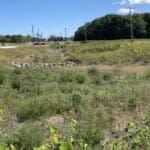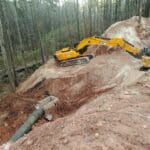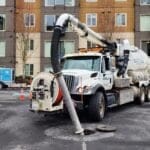City of Auburn
The City of Auburn has enacted a Stormwater Ordinance in order to establish minimum stormwater management requirements and controls to protect and safeguard the general health, safety, and welfare of the public residing in watersheds within this jurisdiction. The City of Auburn is the permitting authority for all land disturbing activities and requires the land owner to maintain all on-site stormwater control facilities and all open space areas (e.g. parks or “green” areas) required by the approved stormwater control plan. The City of Auburn will only provide construction permits to projects that establish a plan to manage stormwater runoff occurring during the construction process. The City of Auburn, under the NPDES program, also has the authority to inspect properties for noncompliance and can issue a notice of violation (NOV) for any deficiency or infraction onsite. Property owners are responsible for the maintenance of any stormwater facilities or practices located on the property. The City of Auburn has the authority to inspect stormwater facilities and practices in order to ascertain that they are properly maintained and functioning.
Excerpt from City of Auburn Code of Ordinances
Title 13 Water, Sewers and Public Utilities; Chapter 13.48 Storm Drainage Utility
3.48.180 Inspection and compliance with storm drainage requirements.
A. The city shall have the authority to establish the necessary recorded instrument that identifies required storm best management practices, location, and maintenance obligations.
B. Duly authorized personnel of the city shall have free access to private property at hours subject to the provisions of ACC 1.20.010 for the purpose of inspecting private storm drainage systems, the manner in which they are being used, and the satisfactory compliance with the provisions of this article.
C. Any property, where the existing storm drainage facilities were constructed per approved construction plans, found to be in nonconformance with such plans, shall be required to correct all such nonconformances as directed by the city. If, after proper notice, the property owner does not comply with set requirements as directed by the city, then the city shall have the authority to correct such nonconformances and bill the property owner for all reasonable costs. Any delinquent payments shall constitute a lien as fixed by ACC 13.06.300.
D. Inspections of storm water treatment and flow control facilities shall be performed by the city at a frequency to comply with the Western Washington Phase II Municipal Stormwater NPDES Permit.
E. New residential developments that are part of a larger common plan of development or sale shall be inspected every six months during the period of heaviest house construction (i.e., one to two years following subdivision approval or until 50 percent of build-out is achieved) to identify maintenance needs and enforce compliance with the maintenance standards as needed.
(Ord. 6617 § 11, 2016; Ord. 6283 § 4, 2009; Ord. 5853 § 1, 2004; Ord. 5212 § 1 (Exh. J), 1999; Ord. 4492 § 4, 1991.)
13.48.225 Drainage standards – Review and approval.
All development shall meet all applicable general and design requirements in accordance with the city of Auburn engineering design and construction standards and, for purposes of that portion of the standards set forth in the City of Auburn Surface Water Management Manual, the following provisions shall apply:
A. Pursuant to the Western Washington Phase II Municipal Stormwater NPDES Permit issued by the Department of Ecology, the city has implemented a storm water management program that requires the use of City of Auburn Surface Water Management Manual, hereinafter referred to as the “SWMM.”
B. The following activities that discharge to the storm drains, either directly or indirectly, are regulated through the storm water management program under this chapter:
1. Existing discharges and land uses that discharge to the storm drains, either directly or indirectly.
2. New development and redevelopment.
3. Storm water maintenance activities.
C. Requirements for Existing Discharges and Land Uses. If the city engineer determines that the discharges from an existing drainage control facility cause or contribute to an illicit discharge, a threat to public health and safety, or a violation of the city’s municipal storm water NPDES permit or this chapter, the city engineer shall require the responsible party to implement and maintain operational BMPs in accordance with Volume IV of the SWMM. If the city engineer determines that the discharges causing or contributing to the problem cannot be adequately addressed by operational BMPs, the city engineer may require the responsible party to undertake more stringent or additional BMPs, which may include structural BMPs or other actions necessary to cease causing or contributing to the problem or violation.
D. Minimum Requirements for New Development and Redevelopment. New development and redevelopment activities are required to obtain city permits and shall comply with the following minimum requirements, in accordance with the city’s municipal storm water NPDES permit and in accordance with the thresholds and requirements in the SWMM:
1. Preparation of a Storm Water Site Plan. All projects shall prepare a storm water site plan for review and approval by the city engineer or designee that identifies and describes how all storm water generated from a development activity will be managed on site. Stormwater site plans shall be designed in accordance with Volume I, Chapter 3 of the SWMM. Exception: Existing single-family and duplex lots are exempt from this requirement when all of the following criteria are met:
a. The lot is located within a subdivision that was approved under storm water regulations in effect between January 1, 1987, and December 31, 2016; and
b. The lot can connect to an existing centralized storm water management system originally designed to collect storm water generated from the entire lot (e.g., house, driveway, patios, yard, etc.).
2. Preparation of a Construction Storm Water Pollution Prevention Plan for Erosion and Sediment Control. This plan shall be designed to comply with the requirements and purposes of the SWMM, this section, any other applicable sections of ACC Titles 15, 16, 17 and 18 and any departmental guidelines promulgated by the city engineer. The plan shall be designed, submitted and implemented to address the following:
a. Mark clearing limits;
b. Establish construction access routes and controls;
c. Control flow rates;
d. Install sediment controls;
e. Stabilize soils;
f. Protect slopes;
g. Protect storm drain inlets;
h. Stabilize channels and outlets;
i. Control pollutants;
j. Control dewatering;
k. Maintain BMPs;
l. Manage the project; and
m. Protect LID BMPs.
3. Source Control of Pollutants. Source control BMPs shall be selected, designed, applied and maintained in accordance with the SWMM and any departmental guidelines promulgated by the city engineer.
4. Preservation of Natural Drainage Systems. Natural discharges from the site shall be maintained, shall occur at the natural location to the maximum extent practicable, and must not cause a significant adverse impact downstream or down gradient.
5. On-Site Storm Water Management. Where appropriate, projects shall employ on-site storm water management BMPs to infiltrate, disperse, and retain storm water runoff on site to the maximum extent feasible without causing flooding, erosion, water quality or groundwater impacts. The city requires the use of low impact development (LID) principles and BMPs using the project thresholds, standards, and requirements presented in the SWMM to meet this minimum requirement. The city shall require low impact development (LID) designed in accordance with the SWMM.
6. Runoff Treatment. All projects that meet the thresholds for runoff treatment in Volume I of the SWMM shall provide water quality treatment in accordance with the SWMM. The use of emerging technologies for storm water treatment will be considered in accordance with Volume V of the SWMM.
7. Flow Control (Detention). All projects that meet the thresholds for flow control in Volume I of the SWMM shall provide flow control in accordance with the SWMM. Additionally, all projects shall address the need to provide water quality controls according to the design criteria as determined by the city engineer. The requirement for storm water detention will also be determined by pipe capacity and storm water discharge location, as provided in the SWMM.
8. Wetlands. Discharges to wetlands shall maintain the hydrologic conditions, hydrophytic vegetation, and substrate characteristics necessary to support existing and designed functions. Documentation shall be provided that identifies the methodology and data that supports these conclusions. The methodology shall be consistent with the most current accepted Washington State Department of Ecology standards. Wetland areas are also regulated by Chapter 16.10 ACC, Critical Areas.
9. Operations and Maintenance. An operation and maintenance (O&M) manual consistent with city engineering design and construction standards shall be provided for all proposed storm water facilities, and the BMPs and party (or parties) responsible for operation and maintenance shall be identified. A copy of the O&M manual shall be retained on site or within reasonable access to the site and shall be transferred with the property to the new owner.
10. Off-Site Analysis and Mitigation. All projects shall include an analysis of off-site water quality and quantity impacts resulting from the project and shall mitigate these impacts if necessary. The analysis shall extend a minimum of one-fourth of a mile downstream from the project. The city engineer may require that the analysis shall extend further if deemed necessary. The existing or potential impacts to be evaluated and mitigated under this section shall include, but are not limited to:
a. Impacts on conveyance system capacity;
b. Localized flooding;
c. Aquatic habitat (wetlands) impacts;
d. Erosion impacts, including landslide hazards;
e. Stream bank and channel erosion; and
f. Impacts to known water quality or erosion problems.
11. Geographic Specific Requirements. Projects may be subject to equivalent or more stringent minimum requirements for erosion control, source control, treatment, wetlands protection, and operation and maintenance, and alternative requirements for flow control as a result of location, in accordance with Volume I of the SWMM.
(Ord. 6617 § 12, 2016; Ord. 6283 § 6, 2009; Ord. 5853 § 1, 2004.)
13.48.435 Inspection and maintenance easement and pollution prevention plan.
All permitted development projects shall require the execution, in accordance with city requirements, of a storm water pollution prevention plan and a standard inspection and maintenance easement agreement that provides for the city to enter the property for inspection of the site’s private storm drainage facilities, and if the owner fails to maintain said system, to perform necessary maintenance. The agreement shall be prepared by the city and executed by the owner prior to the issuance of occupancy permits for the development. (Ord. 5853 § 1, 2004.)
13.48.440 Maintenance responsibility.
A. Private Maintenance Responsibility. The maintenance and operation of private storm drainage systems shall be the responsibility of the property owner. It shall be the responsibility of the developer to make arrangements with the occupants or owners of the subject property for assumption of operation and maintenance in a manner subject to the approval of the city or in accordance with the operations and maintenance program prepared for the property’s storm drainage facilities. The city may inspect the facilities in order to ensure continued use of the facilities for the purposes for which they were built and in accordance with these arrangements. Failure to maintain the facilities in accordance with the maintenance standards listed in the SWMM shall be considered a violation, enforceable in accordance with Chapter 1.25 ACC.
B. Public Maintenance Responsibility. The city shall be responsible for the maintenance and operation of all public storm drainage facilities located within the public easements and rights-of-way following the completion of a successful maintenance period and the acceptance of such facilities by the city. The maintenance shall be performed in accordance with the standards listed in the SWMM. (Ord. 6617 § 17, 2016; Ord. 6283 § 12, 2009; Ord. 5853 § 1, 2004; Ord. 5212 § 1 (Exh. J), 1999; Ord. 4492 § 4, 1991.)
City of Auburn Resources
City of Auburn Code of Ordinances
City of Auburn Stormwater Page
 Kenosha, Wis. Highway KR Regenerative Stormwater ConveyanceThe Root-Pike Watershed Initiative Network Kenosha County, and others worked with AQUALIS to design and implement an innovative solution for stormwater control along Highway KR.
Kenosha, Wis. Highway KR Regenerative Stormwater ConveyanceThe Root-Pike Watershed Initiative Network Kenosha County, and others worked with AQUALIS to design and implement an innovative solution for stormwater control along Highway KR. Durham, N.C. Sinkhole Leads to Stormwater System RehabilitationThe tenant on this property noticed a depression that opened to the ground below and notified the property owners.
Durham, N.C. Sinkhole Leads to Stormwater System RehabilitationThe tenant on this property noticed a depression that opened to the ground below and notified the property owners.
